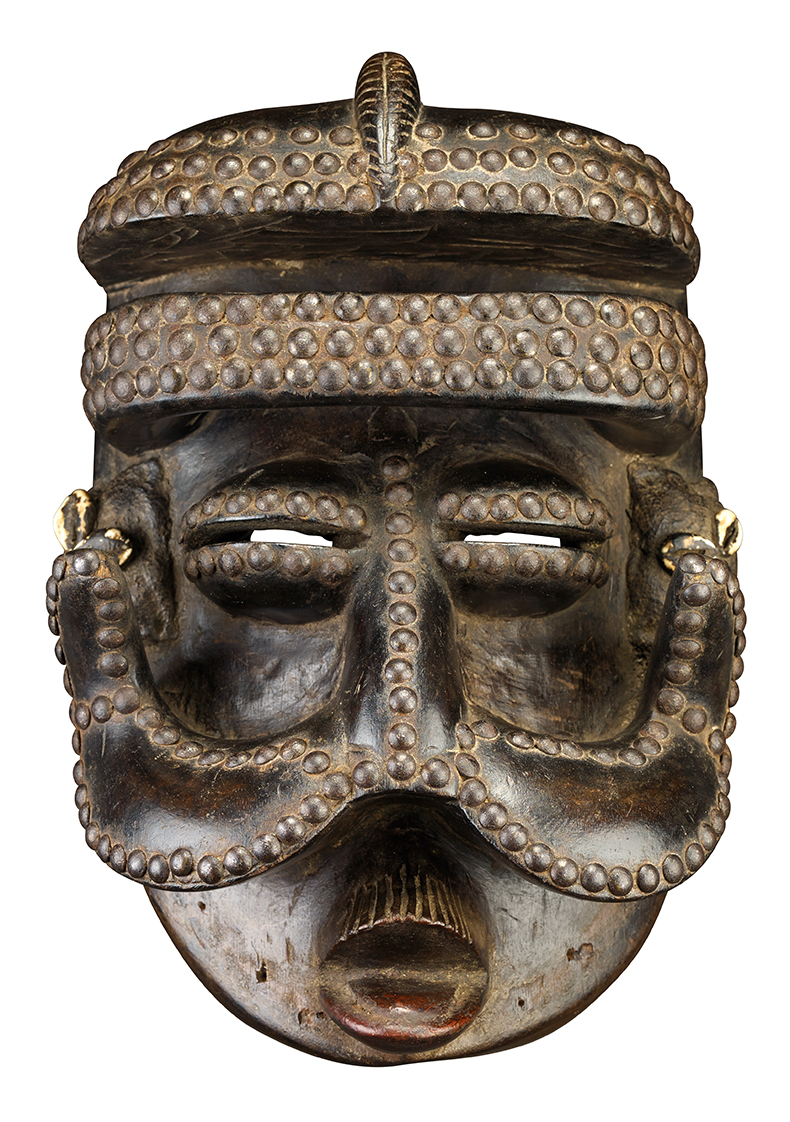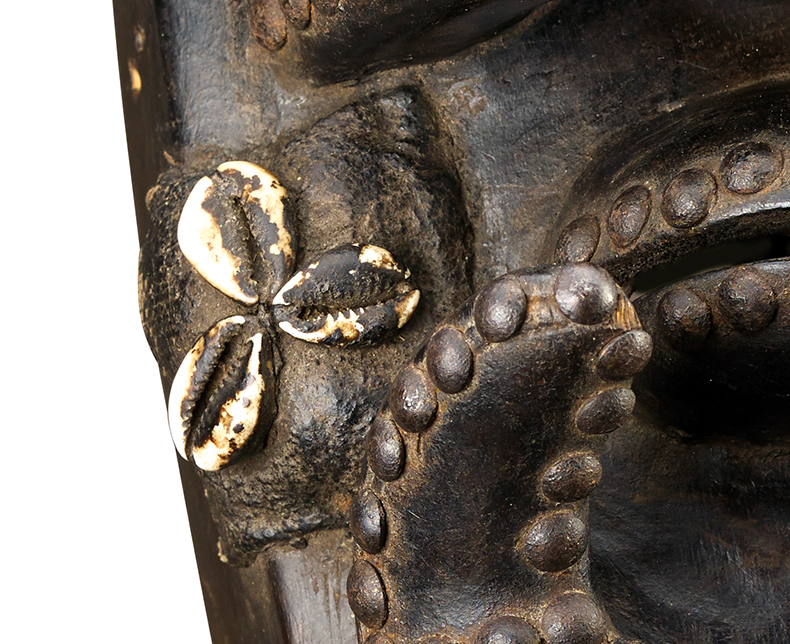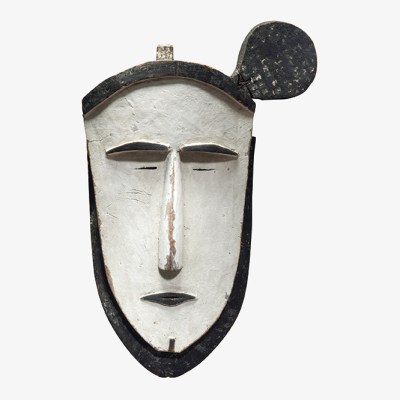From the July/August 2024 issue of Apollo. Preview and subscribe here.
Kevin Dumouchelle of the National Museum of African Art explains what a fearsome 19th-century ceremonial mask meant to its makers in Côte d’Ivoire.
This Bété mask dates to the late 19th century and is a remnant of a larger performative ensemble or masquerade that would have served a regulatory and martial function, embodying spirits of the natural world and representing elders. The Bété people are an ethnic group located in the south-west of Côte d’Ivoire. A patriarchal and patrilineal society, their communities are guided by the heads of each individual lineage, though spiritual and ancestral authority plays a crucial role in maintaining social order. The largely agreed upon anthropological interpretation is that each community would have had their own versions of masks, known as gre or nyabwa, that were called upon to help bring structure to society. There is not a great depth of research in this area, so we have to make assumptions based on conditions observed by ethnographers in the 1920s and ’30s and apply this knowledge retrospectively to objects from the 1870s, ’80s and ’90s.
Face mask, late 19th century, unknown Bété artist. National Museum of African Art, Smithsonian Institution, Washington, D.C.

The mask has a very aggressive, startling, garish quality. It is meant to stop you in your tracks – to intimidate, frighten – giving a sense that the mask and the performer are representing an authority one should be fearful of and submissive towards. We believe that the masquerade served a variety of purposes, including leading soldiers into battle as an emblem of the might and power of the warriors behind it and to intimidate foes on the opposite side.
Typically, these masks would have been accompanied by an elaborate ceremonial costume, made of cloth, raffia and plant materials. The costume would have given the wearer a strong presence, with the wild raffia moving in an aggressive manner, making the body look larger than usual. However, costumes were stripped away when these objects were collected in the 20th century. Feathers, hair and other important attachments were removed, owing to a limited European perspective that valued only the pure, sculptural form of the mask.
The mask has an unnatural quality – the pronounced brow, gaping mouth and piercing eyes staring right at you are designed to grab your attention and give the sense that the mask represents a force greater than oneself. The protrusions curling out from the sides of the nose may suggest a human-animal hybrid, possibly representing powerful tusks, or wild and aggressive facial hair. Other martial or war-like masks from neighbouring communities in Côte d’Ivoire have profusions of both horn and hair on them, and this one might too have had some of those elements attached to it at one point to further enhance its animalistic, ferocious quality.
Face mask (detail), late 19th century, unknown Bété artist. National Museum of African Art, Smithsonian Institution, Washington, D.C.

The inclusion of cowrie shells at the temples of the mask, as well as the small, sealed fibre packs affixed to each side, likely containing earthen matter, enhance the mask’s connection with the natural world – a point of ritual significance. The exact purpose they served is known only to people who were initiated into the secrets associated with this mask; this raises an interesting question within a museum context about whether that is indeed information we should be privy to.
Though we have no specific record of who made this mask, and documentation within these communities is minimal, all evidence suggests that there almost certainly would have been a designated person in the community – a master sculptor – who was responsible for its production. For comparably sized and functionally similar masks created in other regions in Côte d’Ivoire, Liberia and neighbouring areas, there will often be a specific tree or type of wood associated with the given mask, selected both for its physical qualities and for any metaphorical or spiritual properties. The process would have been passed down through master hands to apprentices – the practice of carving the wood and reducing it into what eventually becomes the form of a human face. For this kind of mask, it’s possible that the carver would create the form and give it a finish with organic materials before passing it on to the specialists performing the masquerade.
One of the most remarkable things about this mask is the studs applied across the surface. Their uniformity suggests that they are most likely European-made furniture studs or nails, brought to the Bété by French traders based in the Ivorian coastal settlements of Abidjan and Grand-Bassam. While Côte d’Ivoire was effectively placed under French control after the Conference of Berlin in the 1880s, the French were not typically in these remote communities in an administrative, colonial capacity until the 1920s and ’30s. However, the intriguing confluence of materials in this mask is not unusual in the late 19th century; industrial objects were finding their way into communities across West Africa, and these studs demonstrate how these communities were becoming increasingly connected to global trade patterns.
Face mask, late 19th century, unknown Bété artist. National Museum of African Art, Smithsonian Institution, Washington, D.C.

The studs may also reflect the practice of body modification, in which a specialist will incise patterns on the skin and then apply certain organic materials and medicines to create cauterised bumps that leave patterns behind. Submitting oneself to this painful process is a sign of physical strength and courage, and the markings are valued for their beauty in a number of communities in both west and central Africa.
The mask came to the museum from the collectors Brian and Diane Leyden, who amassed a remarkable private collection of objects and sculptures almost entirely from Côte d’Ivoire. They were particularly interested in collecting objects dated from before the primary French colonial presence – though of course we can see from the studs in this mask that the French were present in the region in some fashion when it was created. It was purchased in the late 1970s from Antwerp-based dealer Lucien Van de Velde, who was travelling in Côte d’Ivoire throughout the 1960s and ’70s acquiring works, but that’s as far back as our records go. We would love to know more about how someone like Van de Velde came into possession of these objects, and that’s part of an ongoing initiative we have of doing deeper provenance research in our collection.
As told to Lucy Waterson by Kevin Dumouchelle, curator at the National Museum of African Art, Smithsonian Institution, Washington, D.C.
‘Visionary: Viewpoints on Africa’s Arts’ is an ongoing exhibition at the National Museum of African Art, Smithsonian Institution, Washington, D.C.
From the July/August 2024 issue of Apollo. Preview and subscribe here.


